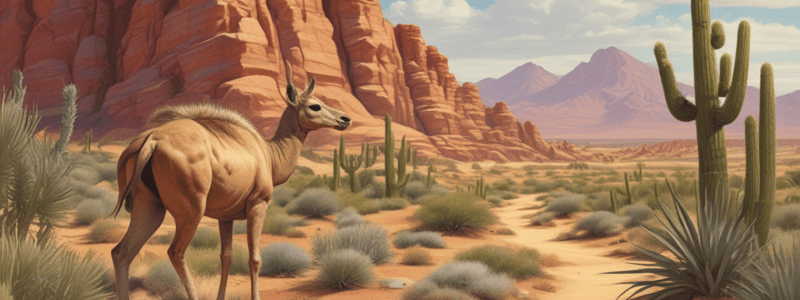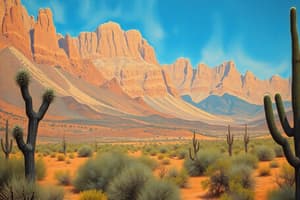Podcast
Questions and Answers
What is the primary reason the desert ant can survive in the Sahara Desert during the daytime?
What is the primary reason the desert ant can survive in the Sahara Desert during the daytime?
- It is immune to the heat and can withstand it indefinitely
- Its long legs elevate its body to a cooler temperature (correct)
- Its body is adapted to withstand temperatures above 60°C
- It has a special cooling system to regulate its body temperature
What is the typical speed at which a desert ant can run?
What is the typical speed at which a desert ant can run?
- 0.5 m/sec
- 2 m/sec
- 3 m/sec
- 1 m/sec (correct)
Why is the desert ant able to forage during the heat of the day when competition for food is low?
Why is the desert ant able to forage during the heat of the day when competition for food is low?
- Because it is a nocturnal animal
- Because its long legs allow it to run fast and minimize exposure time (correct)
- Because it has a special cooling system
- Because it is immune to the heat
What is a common challenge faced by all animals, including the desert ant?
What is a common challenge faced by all animals, including the desert ant?
What is the purpose of the desert ant's long legs in terms of its body temperature?
What is the purpose of the desert ant's long legs in terms of its body temperature?
What is a benefit of the desert ant's speed in terms of its survival?
What is a benefit of the desert ant's speed in terms of its survival?
What is the primary driving force behind the evolution of adaptations in a population?
What is the primary driving force behind the evolution of adaptations in a population?
What is the relationship between anatomy and physiology?
What is the relationship between anatomy and physiology?
What is the focus of the chapter in terms of animal form and function?
What is the focus of the chapter in terms of animal form and function?
What is the role of anatomy in understanding animal physiology?
What is the role of anatomy in understanding animal physiology?
What is the significance of studying animal form and function in relation to their environment?
What is the significance of studying animal form and function in relation to their environment?
Flashcards are hidden until you start studying



